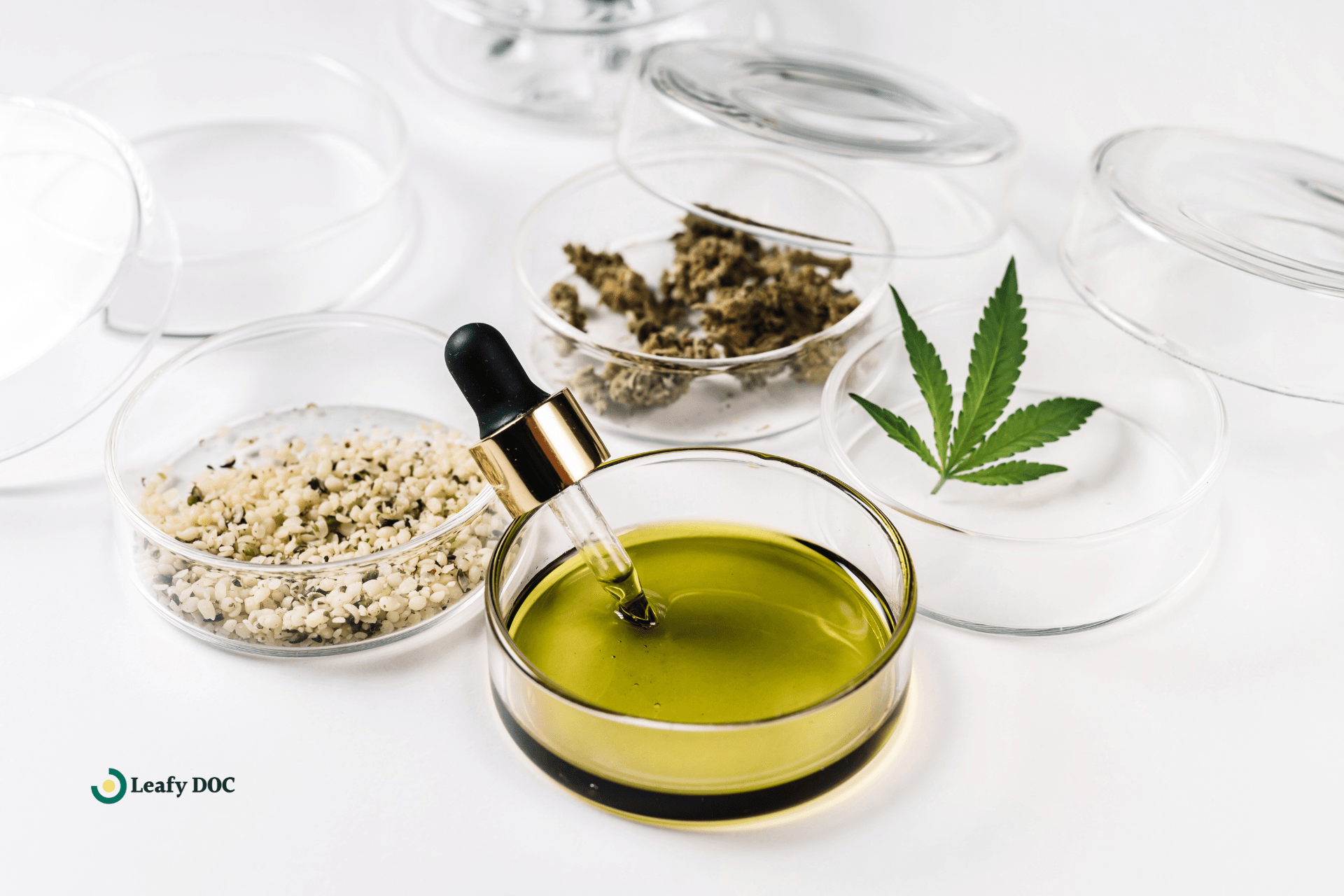Understanding the Forms of Medical Marijuana: Flower, Concentrates, Edibles, and Topicals
by Haley Mills · May 30, 2023
Understand the different forms of medical marijuana and how they can be used to treat various conditions. Learn about the benefits and drawbacks of flower, concentrates, edibles, and topicals.

The world of medical marijuana has expanded significantly over the past few years, with many patients turning to this natural remedy to alleviate a wide range of symptoms and conditions. For those new to the therapeutic use of cannabis, understanding the different forms it can take may seem overwhelming.
This article will explore the most common forms of medical marijuana to help you understand its applications, benefits, and potential side effects. By examining the characteristics of each form, you will be better equipped to make an informed decision about the best option for your individual needs and preferences.
Introduction to Medical Marijuana: The Basics
Medical marijuana is using the cannabis plant and its components, called cannabinoids, to alleviate various symptoms and conditions. The most well-known cannabinoids are tetrahydrocannabinol (THC) and cannabidiol (CBD), which can have a range of therapeutic effects on the body. As the medical marijuana industry has evolved, different forms and methods of consumption have emerged to meet the diverse needs of patients.
The Versatility of Cannabis: Exploring Different Forms
With advancements in technology and an increased understanding of the cannabis plant, medical marijuana is now available in various forms, such as flower, concentrates, edibles, and topicals. Each form has its unique advantages and disadvantages, which we will explore in this section to help you decide on the best types of medical marijuana for you.
Flower: The Traditional Choice for Medical Marijuana
a. Different Strains and Their Therapeutic Effects
Flower, also known as bud, is the most common and traditional form of cannabis. There are numerous strains, each with a unique combination of cannabinoids, terpenes, and other compounds that produce distinct effects. Some indica strains are known for their sedative and relaxing properties, while Sativa-dominant strains often provide an uplifting and energetic effect. Hybrid strains offer a mix of these characteristics.
b. Smoking and Vaporizing: Methods of Consumption
Flower can be smoked using pipes, joints, or water pipes (bongs), which provide quick symptom relief due to the rapid absorption of cannabinoids through the lungs. Alternatively, vaporizing (or vaping) heats the flower without combustion, reducing the production of harmful byproducts while still delivering the active compounds effectively.
Concentrates: Potency and Precision in Treatment
a. Understanding the Types of Concentrates: Wax, Shatter, and Oil
Concentrates are potent cannabis extracts that contain high concentrations of cannabinoids and terpenes. They come in various forms, such as wax, shatter, and oil. These extracts are popular among patients who require higher doses of cannabinoids for symptom relief or prefer a more potent and rapid onset of effects.
b. Dabbing, Vaping, and Tinctures: Ways to Use Concentrates
Dabbing involves heating a small amount of concentrate on a heated surface, typically using a dab rig, and inhaling the resulting vapor. Vaping concentrates can be done using specially designed vaporizers or cartridges. Tinctures are alcohol or oil-based extracts that can be taken sublingually or added to food and beverages.
Edibles: Discreet and Long-Lasting Relief
a. Popular Types of Cannabis-Infused Edibles
Edibles are food products infused with cannabis, such as cookies, brownies, gummies, and beverages. They offer a discreet and convenient way to consume medical marijuana, with longer-lasting effects than smoking or vaping.
b. Determining the Right Dosage for Your Needs
Edibles can take anywhere from 30 minutes to 2 hours to take effect, and the duration can last between 4 to 8 hours. It is crucial to start with a low dose (5-10mg of THC) and wait for the effects before consuming more to avoid overconsumption.
Topicals: Targeted Relief for Aches and Pains
a. Types of Cannabis-Infused Topicals: Creams, Balms, and Lotions
Topicals are cannabis-infused products applied directly to the skin, such as creams, balms, and lotions. They provide localized relief for pain, inflammation, and skin conditions without producing the psychoactive effects associated with THC.
b. Using Topicals for Skin Conditions and Inflammation
Topicals can be used to address various skin conditions, such as eczema, psoriasis, and dermatitis, as well as muscle and joint pain. Simply apply the topical product to the affected area as needed, and it will work by interacting with the skin’s endocannabinoid system.
Understanding the Entourage Effect: The Role of Terpenes and Cannabinoids
The entourage effect refers to the synergistic interaction between cannabinoids, terpenes, and other cannabis compounds, which can enhance the therapeutic benefits of medical marijuana. Different strains and forms of cannabis have unique combinations of these compounds, resulting in diverse effects. Understanding the entourage effect can help you select the right product for your specific needs.
The Importance of Lab Testing and Quality Control
Lab testing is crucial for ensuring the safety, potency, and consistency of medical marijuana products. Reputable manufacturers and dispensaries will provide lab results that verify cannabinoid concentrations, terpene profiles, and the absence of contaminants such as pesticides, heavy metals, and mold.
Navigating the Legality of Medical Marijuana: Laws and Regulations
Medical marijuana laws and regulations vary significantly between countries, states, and local jurisdictions. It is essential to familiarize yourself with the specific regulations in your area, including qualifying conditions, possession limits, and the process of obtaining a medical marijuana card or recommendation.
Since federal law prohibits marijuana use, understanding state medical marijuana laws is crucial for patients and healthcare providers, as regulations vary significantly between states. 38 states, plus the District of Columbia, Guam, Puerto Rico, and the U.S. Virgin Islands, have approved comprehensive public medical marijuana programs. It is essential to stay updated on your state’s legislation, as laws surrounding the cannabis sativa plant may change over time.
Here, we will provide an overview of some specific aspects of state medical marijuana laws, highlighting a few examples to illustrate the variation between states.
- Qualifying Conditions Each state has its own list of qualifying medical conditions for which medical marijuana can be recommended or prescribed. Common qualifying conditions for legalized cannabis include cancer, epilepsy, chronic pain, glaucoma, HIV/AIDS, multiple sclerosis, and Crohn’s disease. Some states, like California, have more flexible laws, allowing physicians to recommend medical marijuana for any severe or debilitating condition they see fit. Others, like Florida, have a specific list of qualifying conditions patients must meet to be eligible. The National Cancer Institute supports MMJ use for cancer-related symptoms.
- Application Process and Medical Marijuana Cards Patients typically need to apply for a medical marijuana card or receive a doctor’s recommendation before accessing medical marijuana. The application process varies by state and may require documentation from a healthcare provider, proof of residency, and a fee. In some states, like Michigan, minors can access medical marijuana with parental consent and specific medical conditions.
- Possession and Cultivation Limits States often limit the amount of medical marijuana a patient can possess or cultivate. For example, in Colorado, patients can possess up to 2 ounces of medical marijuana and grow up to six plants (with no more than three being mature, flowering plants). In contrast, Oregon allows patients to possess up to 24 ounces and cultivate up to six mature and 18 immature cannabis sativa plants.
- Dispensaries and Access The availability of medical marijuana dispensaries and the rules governing their operation also vary between states. Some states, like Oklahoma, have relatively relaxed regulations, leading to many dispensaries. In contrast, states like Minnesota have a more limited number of dispensaries and stricter operational regulations.
- Reciprocity Some states offer reciprocity, meaning they will recognize medical marijuana cards from other states, allowing out-of-state patients to access medical marijuana while visiting. However, this is not a universal practice, and it is essential to research the specific rules in the state you are visiting.
- Some states have CBD-only laws, which permit CBD products with low THC content for specific medical conditions, typically severe epilepsy. These laws are more restrictive than comprehensive medical marijuana programs, as they limit the types of products available to patients.
The Role of Medical Professionals in Cannabis Treatment
Consulting with a healthcare professional experienced in medical marijuana is essential before starting any new treatment. They can provide personalized guidance and recommendations based on your medical history, symptoms, and other factors, ensuring you use medical marijuana safely and effectively.
Potential Side Effects and Interactions: What to Watch Out For
While medical marijuana is generally considered safe, consuming cannabis can cause side effects in some individuals, such as dizziness, dry mouth, and increased heart rate. Cannabis use can also interact with certain medications, so you must inform your healthcare provider of all medications and supplements you are taking.
Medical marijuana has proven to be an effective treatment for various medical conditions; per the National Institute on Drug Abuse, there is a potential risk of developing substance use disorders, primarily if used without proper guidance or in ways that deviate from prescribed medical use. The risk factors for developing a problem with marijuana use are similar to those associated with other substances. They can depend on individual factors, frequency of use, and the potency of cannabis products.
Titration and Finding the Right Dosage for Your Needs
Titration is gradually adjusting the dose of medical marijuana to find the most effective sativa and indica plants and comfortable levels of THC/CBD for your specific needs. Start with a low dose and increase it slowly, noting how your body responds to the treatment. This approach minimizes the risk of side effects and helps you find the optimal dosage.
Conclusion: Choosing the Right Medical Marijuana For You
In conclusion, medical marijuana comes in various forms, including flower, concentrates, edibles, and topicals, each with unique benefits and drawbacks. By understanding these different forms, you can more effectively navigate the world of medical cannabis and find the best treatment option for your specific needs.
Remember that it’s essential to consult with a healthcare professional experienced in medical marijuana before starting any new treatment, as they can provide personalized guidance and recommendations tailored to your unique situation. With a thorough understanding of the diverse forms of medical marijuana, you can make informed decisions about your healthcare and potentially find relief from a myriad of symptoms and conditions through cannabis plants.
Last Updated: August 8, 2024
Get Approved for Your Medical Marijuana Card in Minutes!

Get Your Medical Card
Connect with a licensed physician online in minutes

Like This Article?
Share with your friends
Table of Contents
Keep Reading
-
11 420 Friendly Cities In The United States
Explore the top 420 friendly cities in the US! From laid-back vibes to cannabis culture, find your perfect destination for a high time.
-
Improving Palliative Care With Cannabis
Revolutionize Palliative Care: Find Relief with Cannabis, Minus Side Effects. Click to discover how cannabis is transforming patient experiences and improve your palliative care today!
-
Unveiling The Psychological Effects Of Medical Marijuana
Uncover the Positive Psychological Effects of Medical Marijuana – Elevate Your Mood and Relieve Anxiety Today! Explore the fascinating benefits of cannabis for mental well-being. Click to learn more!



